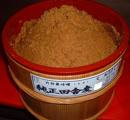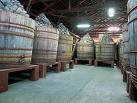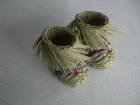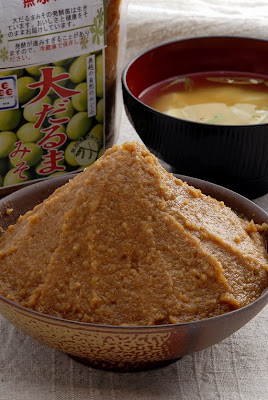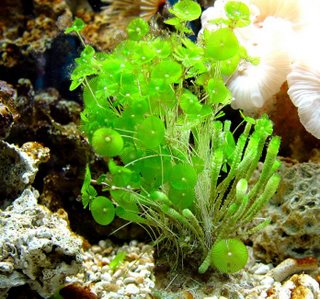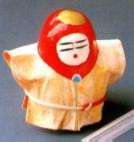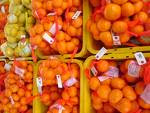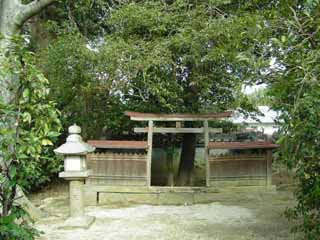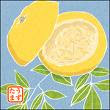::::::::::::::::::::::::::::::::::::::::::::::::::::::::::::::::::::::::::::::::::::::::::::::::::::
Rice cakes (mochi 餅)
***** Location: Japan
***** Season: Various
***** Category: Humanity
*****************************
Explanation
Mochi are used in many kinds of food, from soup to sweets. Mochi can be grilled, fried, and simmered.
The Japanese have traditionally believed that all material things are imbued with spirits, and so by partaking of the rice mochi - thought to symbolize the spirit of rice - they hoped to gain the strength of these rice divinities for themselves.
. Mochi 餅 rice cakes and 妖怪 Yokai monsters .
sticky rice cake, rice dough

Pounding Rice (mochi tsuki)
kigo for mid-winter
... 雑煮 (ぞうに) New Year Soup
kigo for the New Year
Kagami mochi ... 鏡餅 ... Decoration Rice cakes for the New Year
kagamibiraki 鏡開き "opening the mirror"
kigo for the New Year
. . . . . Sweet Mochi
WAGASHI ... Sweets SAIJIKI
. . . . . Food Mochi
WASHOKU ... SEASONAL DISHES SAIJIKI

Mochinage 餅なげ (もちなげ) throwing mochi
is a great social event, when the important participants of a festival or cheremony throw bags full of white and red mochi for good luck to the crowds.
. . . CLICK here for Photos !
Abekawa Mochi 安倍川餅 rice cakes from Abekawa river, with kinako soy bean flour
Once eaten by Tokugawa Ieyasu, because the local producers told him the kinako flower was really gold powder.
. kinako 安倍川の金な粉餅 pun with Gold Powder .
Akumochi, aku-mochi あくもち / 灰汁餅 for 5.5. Boy's festival.
with mochigome and lye.
akumaki あくまき(灰汁巻き)mochigome rice cakes, Chimaki
Kagoshima prefecture
Ankoro mochi, ankoromochi あんころもち (餡ころ餅, あんころ餅) wrapped in sweet bean paste, an
They are prepared in Kyoto for the hottest days of summer (doyoo) and eaten with the hope to ward off evil and get stamina for the summer.
. . . CLICK here for Photos !
. Benkei no Chikaramochi 弁慶の力餅
Mochi for the strong monk-warriour Benkei
Offered at various temples in Japan
Botamochidera Temple in Kamakura
in memory of Saint Nichiren
ebimochi 海老餅 mochi with shrimp
slightly roasted shripm, the mochi are red-pinkish
Echi no Goshiki Mochi 越の五色餅
Mochi in five colors, from Echi (Echizen/Echigo)

Special rice from "Remote Echi" 奥越 is used together with black beans, soy beans, millet, yomogi mugwort and others.
goshiki mochi for Saint Nichiren
and more about the "five colors"
ekoeko kinako mochi エコエコきなこ餅 Eco eco ... ecologically useful mochi
made from azuki beans which are usually thrown away for less quality.
Sentaroo no ekoeko wagashi / eco eco wagashi

仙太郎のエコエコ和菓子
仙太郎 エコエコぼうろ Sentaroo eko eko hooro Sentaro Eco eco
The leftovers from boiling red beans are baked in the dough.
☆ 京菓子司 仙太郎 本店 ☆
京都市下京区寺町通り仏光寺上る中之町576
http://www.sentaro.co.jp/
Wagashi no o-hanashi
http://www.sentaro.co.jp/saijiki/saijiki/saijiki.html
. fukumochi shinji 福餅神事(ふくのもちしんじ)
"ceremony of auspicious mochi rice cakes"
at Sumiyoshi Shrine
kigo for the New Year
gyuuhi mochi 求肥餅 / ぎゅうひ餅 gyuhi mochi
The dough is whipped to get more air into the mochi and thus they taste more bubbely and soft.
often wrapped in kinako powder or sesame seeds.
They can be colored in white and pink for auspicious occasions.
. . . CLICK here for Photos !
gyuuhi too 求肥糖
gyuuhi ame 求肥飴(あめ)
. hiuchi yaki 火打焼 a kind of mochi
a kind of gyuhi mochi from shrine Kasuga Taisha.
Hakata no shio mochi 伯方の塩餅
shio daifuku 塩大福
flavored with Hakata salt
. . . CLICK here for Photos !
Salz-Mochi aus Hakata 384
. horagai mochi 法螺貝餅 Horagai sweets .
- - - - - and
gyooja mochi 行者餅 Mochi for Yamabushi mountain priests
igusa no warabimochi いぐさわらび餅 fern mochi with igusa rush grass
from Okayama
igusa, Juncus decipiens Nakai
Irikomochi, いりこもち Toshikazumochi from Miyazaki
. . . CLICK here for Photos !
. irimochi 煎餅 Senbei .
Isobemaki 磯部まき (いそべまき) mochi wrapped in nori seaweed
roasted and dipped in soy sauce
. . . CLICK here for Photos !
. kawabitarimochi 川浸り餅(かわびたりもち)
mochi prepared on the day of kawabitari
kigo for early winter
. . . . . also called
otogomochi otogo mochi 乙子餅
"mochi for the youngest child"
kibi mochi きび餅 millet mochi
with different kinds of millet grains pounded together with mochigome rice.
. . . CLICK here for Photos !
Kokubun-ji Daifuku 国分寺大福 Kokubunji-Dumpling From Temple Kokubun-Ji, Shizuoka
kurimochi 粟餅 mochi with sweet chestnuts
made since olden times.
kuromame tobo mochi 黒豆とぼ餅 mochi with black soy beans
From Fukui prefecture.
tobo is a stick with which the masu box for measuring grains was brushed straight.
. . . CLICK here for Photos !
kurosato mochi 黒砂糖餅 mochi with black sugar
they are usually dark brown.
. . . CLICK here for Photos !
also
kuroto mochi 黒糖餅 mochi with black sugar
kusamochi くさ餅 mugwort rice cakes
The young mugwort leaves are boiled and added when pounding mochigome rice. The fragrance of mugwort is supposed to ward off evil influences in your life. The aroma comes from cineole and essential oils. mugwort is rich in vitamins A, B1, B2 and C and contains iron, phosphorus and calcium.
They are eaten at the Doll Festival, March 3.
kusudama 薬玉(クスダマ)is another word for these mochi.
kigo for mid-spring
kuzumochi くずもち, 葛もち from arrowroot
Usually served with kinako. . . CLICK here for Photos !
Küchlein aus Pfeilwurzel-Stärke
also
kuzu no sashimi 葛の刺身 kuzu sliced like sashimi
served with a perilla leaf. Temple food.
. . . CLICK here for Photos !
kuzuage 葛揚げ deep fried ingredients wrapped in kuzu starch, for example small tomatoes or pickled salted plums, umeboshi kuzuage 梅干葛揚げ
mamemochi, mame mochi 豆餅 soy beans mochi
Soy beans are pounded together with mochigome rice.
. . . CLICK here for Photos !
miso chigirimochi 味噌ちぎり餅 with miso flavor
other types of chigirimochi
. . . CLICK here for Photos !
. muuchii 鬼餅 (むうちい . ムーチー) muchi,
"demon mochi"
observance kigo for mid-winter : Okinawa
. 長まし Nagamashi mochi
Ishikawa Prefecture, Nanao town
. . . . .
sobamochi, soba mochi そば餅 buckwheat mochi
Buckwheat seeds are pounded together with the mochigome rice.
. . . CLICK here for Photos !
Buchweizen-Mochi
tanjooiwaimochi, tanjoo iwai mochi 誕生祝い餅(たんじょういわいもち)
isshoomochi 一升餅・一生餅(いっしょうもち)
mochi for the first birthday of a baby
fumimochi 踏み餅 "stand with both feet on the earth" mochi
 The round mochi weights isshoo (一升, ca. 1,8 kg) and is put into a rucksack for the baby to carry. If it does so without crying, it will have rice to eat for his whole life (isshoo 一生).
The round mochi weights isshoo (一升, ca. 1,8 kg) and is put into a rucksack for the baby to carry. If it does so without crying, it will have rice to eat for his whole life (isshoo 一生).The round mochi also represents the sun and the sun deity Amaterasu.
They are also sometimes used for other important birthdays, especially when people get older, with the wish for a long life.
I once was present of the birthday party of a little boy who carried it with great joy.
tochimochi, tochi mochi とち餅
dumplings from horse chestnuts
Speciality of Tottori. They are usually brown.
. . . CLICK here for Photos !
tonsho mochi 屯所餅(とんしょもち)"garrison mochi"
. . . CLICK here for Photos !
Eaten in memory of the Shinsengumi in 1863, near Temple Mibudera.
The leafy vegetable mibuna 壬生菜 is cut finely, and mixed with dainagon azuki red beans 大納言小豆.
Reference : Shinsengumi Peacekeeping samurai group in Kyoto
Shinsengumi Daruma Doll 新選組だるま
. . . . .
tooji mochi 冬至餅(とうじもち) ricecakes for winter solstice
kigo for mid-winter
urumochi うる餅 mochi with flower from uruchigome
うるち米 uruchigome, rice flour of Oryza sativa
Ushiwaka mochi 牛若餅 from the Kurama Mountain, Kyoto
Named after Minamoto no Yoshitsune in his boyhood (Ushiwaka, the one as strong as a bull), when he was trained at the Kurama Mountain Temple by the Forest Goblins (tengu).

. . WKD : Kurama Mountain Festivals
- - - . Minamoto no Yoshitsune 源の義経 (1159 - 1189) .
- Introduction -
牛若丸 Ushiwakamaru (his boyhood name at Kurama)
Warabimochi 蕨餅 / 笑来美餅 from Bashodo, Osaka
Fern Mochi, mochi with bracken powder
Adlerfarn-Mochi
warabiko わらび粉 Stärke aus dem Wurzelstock des Warabi-Farns.
:::::::::::::::::::::::::::::::::::::::::::::::::::::::::::::::::::::::::::::::::::::::::::::::::::::
yakimochi やきもち (焼き餅) to roast mochi over hot ambers
. . . CLICK here for Photos !
also
a pun on the sounds of YAKI and KIMOCHI
to be jealous of someone 妬き餅、嫉妬 yakimochi
These mochi were used to tell the fortune of lovers.
If two rice cakes puffed at the same time and the tops touched each other, this signified that all would be well and happy in your love-life.
If they did not plop close together, you could push the mochi closer together and hope for the best.
This fun by the fireplace was called "yakimochi o yaku", to be jealous.
There is even a special sweet soy sauce to go with the grilled mochi rice cakes.
醤油焼餅しょうゆ
Ceremony for yakimochi at the shrine Takabayashi
高林神社焼き餅会
February 2
in Gunma, Ota Village 太田

© PHOTO : Abe Tomoyo
. . . CLICK here for Photos !
During the great famine of Tenmei after the eruption of Mount Asama the people of Takabayashi village on the river Ishisagawa 石田川 found a wooden statue of Fudo Myo-O in the water and saved it. To celebrate, they used the last bits of small grains of rice and millet (awa, hie) for mochi dough and fried some leaves of daikon radish and other wild leaves for the filling. They presented these mochi to the deity and celebrate it to this day. The mochi are good for pregnant woman. The mothers of the villge come to this shrine to celebrate on January and August 28, the memorial days of Fudo Myo-O.
Yakimochi Fudoo Son 焼き餅不動尊
Since 1783
WASHOKU : Famine in Japan 天明の大飢饉
. yakimochi Jizoo やきもち地蔵 Jizo for jealousy .
Joorakuji 常楽寺 Joraku-Ji Jorakuji
群馬県館林市木戸町580, Tatebayashi town, Gunma
.............................................................................
焼餅に烏の羽や春の雨
yakimochi ni karasu no hane ya haru no ame
a crow's feather
on the toasted rice cake...
spring rain
Kobayashi Issa
Tr. David Lanoue
:::::::::::::::::::::::::::::::::::::::::::::::::::::::::::::::::::::::::::::::::::::::::::::::::::::
yomogimochi よもぎ餅 mochi with ground mugwort
kigo for mid-spring
Beifuss-Mochi
They are well loved because of their fresh green color.
also called: kusamochi 草もち, see above.
. . . CLICK here for Photos !
::::::::::::::::::::::::::::::::::::::::::::::::::::::::::::::::::::::::::::::::::::::::::::::::::::
Types of flower used for mochi
domyojiko, doomyoojiko どうみょうじこ (道明寺粉)
dried and granulated glutinous rice flour
Domyoji-ko
for kashiwamochi, sakuramochi
. . . CLICK here for Photos !
. Domyo-Ji Temple Festivals
joshinko, jooshinko じょうしんこ (上新粉)nonglutinous rice flour
regular rice flour
for kusamochi
. . . CLICK here for Photos !
shiratama-ko 白玉粉, shiratama-ko rice flour
used in Tokyo for sakuramochi
Shiratama 白玉 (しらたま) Shiratama Dango dumplings
:::::::::::::::::::::::::::::::::::::::::::::::::::::::::::::::::::::::::::::::::::::::::::::::::::
Mochi (Japanese: 餅; Chinese: 麻糬) is a Japanese and Chinese rice cake made of steamed glutinous rice pounded into paste and molded into shape. In Japan it is traditionally made in a ceremony called mochitsuki. While also eaten year-round, mochi is a traditional food for the Japanese New Year and is commonly sold and eaten during that time.
Mochitsuki is the traditional mochi-pounding ceremony in Japan.
Polished glutinous rice is soaked overnight and cooked.
The cooked rice is pounded with wooden mallets (kine) in a traditional mortar (usu). Two people will alternate the work, one pounding and the other turning and wetting the mochi. They must keep a steady rhythm or they may accidentally injure one another with the heavy kine.
The sticky mass is then formed into various shapes (usually a sphere or cube).
Mochi may also be made in an automatic mochi machine, similar to a breadmaker. In fact, mochi can be made using a breadmaker if the rice is soaked and steamed separately and the machine can be started in a kneading mode.
Making mochi at home is possible without an automatic machine. Use a bamboo steamer or other apparatus that the sweets will not stick to while steaming. Add only enough water to allow the flour to stick together, form a small circle of the dough, then put a small amount of bean paste in the center. Close the dough over the paste and place in the steamer until the mochi congeals. Immediately upon removing the mochi from the steamer, coat the mochi in more sweet rice flour to prevent it from sticking to the hands of the maker.
Confectionery
Many types of traditional wagashi (Japanese traditional sweets) are made with mochi. For example, daifuku is a soft round mochi stuffed with sweet filling, such as sweetened red bean paste (an) or white bean paste (shiro an). Ichigo daifuku is a version containing a whole strawberry inside.
Kusa mochi is a green variety of mochi flavored with yomogi (mugwort). When daifuku is made with kusa mochi, it is called yomogi daifuku.
Mochi ice cream
Soup
Oshiruko or ozenzai is a sweet azuki bean soup with pieces of mochi. In winter, Japanese people often eat it to warm themselves.
Chikara udon (meaning "power udon") is a dish consisting of udon noodles in soup topped with toasted mochi.
Zōni soup. See New Year specialties below.
New Year specialties
Kagami mochi is a New Year decoration, which is traditionally broken and eaten in a ritual called Kagami biraki (mirror opening).
Zōni, zooni soup is a soup containing rice cakes. Zoni is also eaten on New Year's Day. In addition to mochi, zoni contains vegetables like honeywort, carrot, and red and white colored boiled kamaboko.
Kinako mochi is a mochi dish that is traditionally made on New Year's Day for luck. This style of mochi preparation includes roasting the mochi over a fire or stove, and then dipping it into a mixture of soy sauce, water and sugar, before finally briefly coating it in kinako (soy flour).
Others
Dango is a Japanese dumpling made from mochiko (rice flour).
Warabimochi is not true mochi, but a jelly-like confection made from bracken starch and covered or dipped in kinako (sweet toasted soybean flour). It is popular in the summertime, and often sold from trucks, not unlike ice cream trucks in Western countries.
More recently, "Moffles" (a waffle like machine used to cook mochi) has been introduced with much fanfare.
© More in the WIKIPEDIA !
more MOCHI reference
:::::::::::::::::::::::::::::::::::::::::::::::::::::::::::::::::::::::::::::::::::::::::::::::::::::
Kinako (黄粉 or きなこ),
also known as roasted soybean flour, is a product commonly used in Japanese cuisine. In English, it is usually called "roasted soy flour." More precisely it is "roasted whole soy flour." Usage of the word kinako appeared cookbooks from the late Muromachi period (1336 – 1573).
Kinako means "Yellow flour" in Japanese.
© More in the WIKIPEDIA !
. daizuko 大豆粉 soybean flour, soy flour .
:::::::::::::::::::::::::::::::::::::::::::::::::::::::::::::::::::::::::::::::::::::::::::::::::::::
ohagi おはぎ wrapped rice cakes
sweet rice balls
wrapped in sweet bean paste, sprinkled with kinako.
They are an offering during the ancestral celebrations at the autumn equinox.
hagi 萩 is the bush clover, one typical blossom of autumn.
. . . CLICK here for Photos !
kigo for mid-autumn
WKD : Autumn equinox 秋彼岸 aki higan
キットカットきなこおはぎ Kitkat sweet with ohagi and kinako taste
. . . CLICK here for Photos !
. Kit Kat for Valentines with Daruma
*****************************
Worldwide use
das Mochi; Reiskuchen
糯 mochi, Klebreis
Ohagi: Mochireis-Klößchen, mit Anko bedeckt
mochitsuki Neujahr 118
Momotaro Mochi 310
sakuramochi „Kirschblüten-Mochi" 172
yomogimochi, tsukimimochi Beifuss Mochi 314
*****************************
Things found on the way

PROVERB
mochi wa mochiya 餅は餅屋
mochi are best made by a mochi specialist
Leave rice cakes to the rice cake makers.
Leave difficult things to the specialist.
Reference
*****************************
HAIKU
All haiku with MOCHI by
. Matsuo Basho 松尾芭蕉 - Archives of the WKD .

Mochi no Hosomichi もちの細道 in Memory of Basho
:::::::::::::::::::::::::::::::::::::::::::::::::::::::::::::::::::::::::::::::::::::::::::::::::::::::
塩からい餅のうれたる茂り哉
shiokarai mochi no uretaru shigeri kana
business is good
in the shade of a tree --
salty rice cakes
Kobayashi Issa 小林一茶
This hokku is from the 5th month (June) of 1812, when Issa is traveling around in the area just east of Edo. A shigeri (a summer season word) is a leafy tree or group of trees under which people can escape the hot summer sun. It's often linked with the feeling of freshness you get when you stand under fresh new leaves. Salty baked rice cakes and thinner salty rice crackers are often eaten in summer to replenish body salt, although they are popular in every season. A traveling rice cake seller has set down his boxes (probably carried hanging from both ends of a pole over his shoulder) under a large, shady tree presumably by the road. The hokku before this one in Issa's diary says Issa is standing in the shade of a single tree, so I've translated shigeri as one tree.
Translation and comment by Chris Drake

shiomochi 塩もち "mochi with salt"
They are still quite popular in our days, the one's with Salt from Hakata are especially famous.
Some also sell a kind of mochi-manju with salt in the red bean paste.
:::::::::::::::::::::::::::::::::::::::::::::::::::::::::::::::::::::::::::::::::::::::::::::::::::::::

隣住む貧士に餅を分ちけり
tonari sumu hinshi ni mochi o wakachi-keri
with the poor man
who lives next door
I share some mochi . . .
Masaoka Shiki 正岡子規
http://www.geocities.co.jp/Hollywood-Kouen/9280/shikiku/shikiku10.htm
*****************************
Related words
Mochi from the KANTO region
***** WASHOKU : sweet mochi of spring
***** WASHOKU : INGREDIENTS
::::::::::::::::::::::::::::::::::::::::::::::::::
[ . BACK to DARUMA MUSEUM TOP . ]
[ . BACK to WORLDKIGO . TOP . ]
:::::::::::::::::::::::::::::::::::::::::::::::::::::::::::::::::::::::::::::::::::::::::::::::::::::::::::::::::::::::::::
